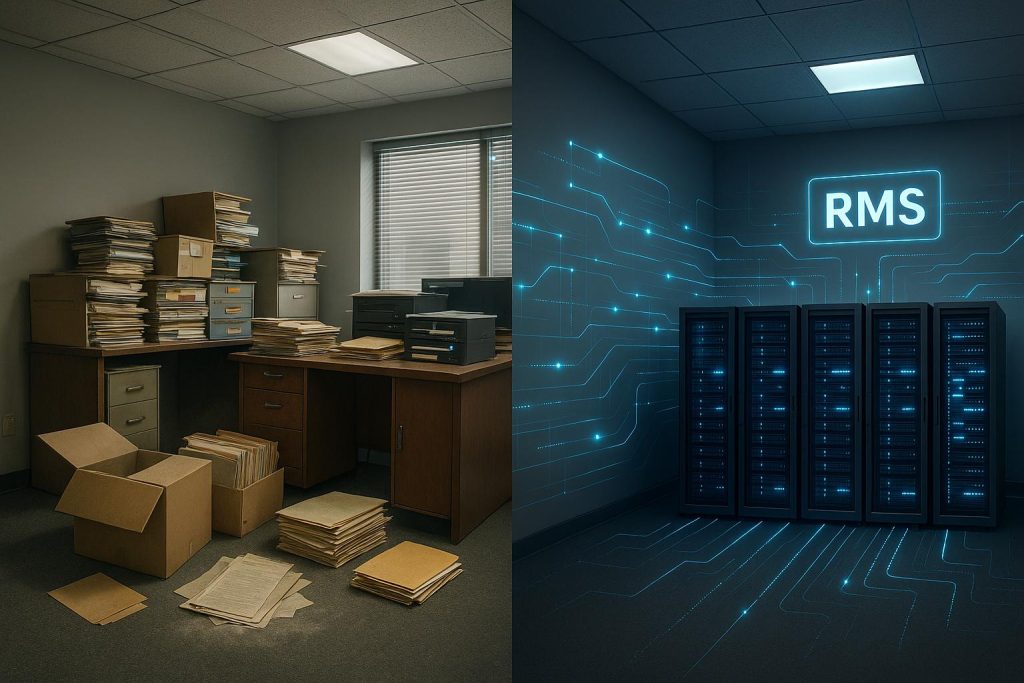Listen to the article
The evolution of Records Management Systems (RMS) is driven by cloud technology, AI automation, and strict compliance demands, transforming RMS into strategic enablers of organisational resilience and digital innovation.
Traditionally viewed as a straightforward process focused on document recording, records management has undergone a profound transformation in the digital age. The integration of cloud computing, AI-driven automation, and stringent compliance frameworks has elevated Records Management Systems (RMS) beyond mere archival functions to become critical enablers of security, efficiency, and regulatory adherence. According to a recent Deloitte report, however, many systems remain vulnerable to challenges like data overload, inconsistent retrieval tools, and non-compliant data disposition that threaten organisational resilience and compliance.
The urgency for a robust RMS framework is underscored by three pressing challenges faced by organisations today: the exponential growth of data volume and variety, the complexity of regulatory compliance requirements, and rising security risks from cyber threats. Legal mandates such as the European Union’s GDPR, the California Consumer Privacy Act (CCPA), and sector-specific directives like HIPAA and the Department of Defense’s 5015.02 standard impose rigorous standards on how data must be stored, accessed, and securely destroyed. Non-compliance not only risks substantial financial penalties but also damages client trust and corporate reputation, as highlighted by compliance experts who stress the moral and legal imperatives of proper data stewardship.
In response, a modern RMS integrates cloud technology for scalability, remote accessibility, and disaster recovery. Cloud adoption ensures that data is safely stored offsite, enabling business continuity even under adverse conditions. Equally critical is the deployment of AI algorithms that automate classification, metadata extraction, and compliance monitoring. AI can proactively flag records for retention or disposition and detect anomalies that might signify compliance breaches, reducing reliance on manual processes and mitigating human error. Security protocols embedded within these systems typically include end-to-end encryption, multi-factor authentication, granular role-based access controls, and exhaustive audit trails—each acting as a safeguard against unauthorised access and breaches.
Interoperability also plays a pivotal role, with RMS platforms increasingly designed to integrate seamlessly with existing email, collaboration, and ERP systems. This enhances metadata consistency and facilitates automation and analytics, fostering a holistic approach to data governance. For successful implementation, organisations are advised to conduct thorough records inventories, develop comprehensive policies aligned with evolving legal landscapes, and prioritise user training and change management to overcome cultural resistance and drive adoption.
Several experts point to regular monitoring and auditing as essential to maintaining system efficacy, enabling ongoing compliance checks and performance benchmarking. RMS plays a frontline role in managing compliance risks by supporting critical processes such as retention scheduling, facilitating ‘right to erasure’ requests securely and transparently, and expediently responding to data breach incidents through ready access to affected records.
A key benefit of contemporary RMS lies in its contribution to digital transformation efforts. By streamlining record-keeping workflows, enabling rapid integration of emerging technologies, and supporting real-time data analytics, a well-structured RMS enhances organisational agility. It provides a foundation that allows enterprises to adapt quickly to regulatory shifts or strategic events such as mergers and acquisitions.
Looking ahead, the evolution of records management is set to be marked by increasing automation—with AI further automating classification, retention, and compliance oversight. Emerging technologies like blockchain are being explored for their potential to provide tamper-proof audit logs, bolstering security and transparency. Privacy-by-design principles will gain prominence, ensuring that systems are architected to embed privacy protections inherently. Moreover, RMS platforms will deepen integration within cloud-native ecosystems, amplifying their scalability and functional interoperability.
Despite these advancements, caution is warranted as AI-powered automation also carries risks if not governed properly. Errors in classification or oversight of compliance requirements could lead to security and regulatory vulnerabilities. Hence, a balanced approach combining technological innovation with robust governance frameworks remains paramount.
In summary, a modern Records Management System is no longer a mere compliance tool; it is a strategic asset vital for operational efficiency, risk mitigation, and digital resilience. Organisations investing in advanced RMS capability stand to achieve not only regulatory compliance but also enhanced trust among stakeholders and strengthened preparedness for future regulatory and technological changes.
📌 Reference Map:
- Paragraph 1 – [1], [4]
- Paragraph 2 – [1], [2], [5]
- Paragraph 3 – [1], [6]
- Paragraph 4 – [1], [3], [7]
- Paragraph 5 – [1], [3], [5]
- Paragraph 6 – [1], [3], [6]
- Paragraph 7 – [1]
Source: Fuse Wire Services


